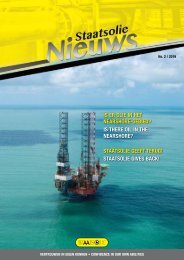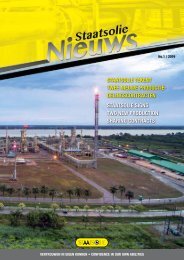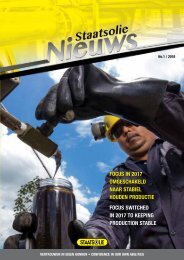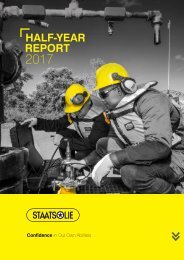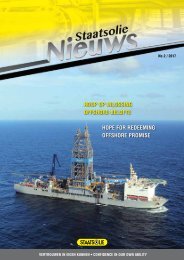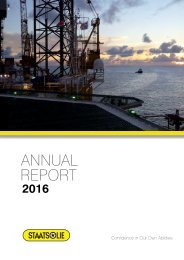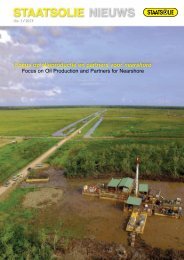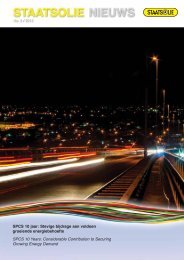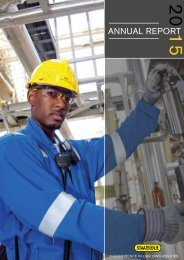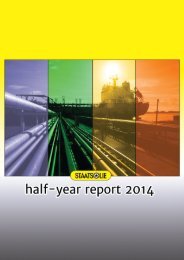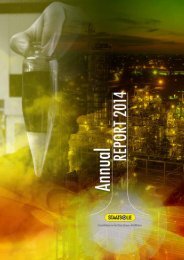Staatsolie Annual Report 2017
Create successful ePaper yourself
Turn your PDF publications into a flip-book with our unique Google optimized e-Paper software.
<strong>Annual</strong> <strong>Report</strong> <strong>2017</strong> 63<br />
<strong>Staatsolie</strong> Maatschappij Suriname N.V.<br />
<strong>Staatsolie</strong> Maatschappij Suriname N.V.<br />
Notes to the Consolidated financial statements for the years ended December 31, <strong>2017</strong> and 2016<br />
(continued)<br />
Notes to the Consolidated financial statements for the years ended December 31, <strong>2017</strong> and 2016<br />
(continued)<br />
Inventories are stated at the lower of cost and net realizable value. Net realizable value is the estimated<br />
Inventories are stated at the lower of cost and net realizable value. Net realizable value is the estimated<br />
selling price in the ordinary course of business, less estimated costs of completion and the estimated<br />
selling price in the ordinary course of business, less estimated costs of completion and the estimated<br />
costs to sell.<br />
costs to sell.<br />
The cost of crude oil and refined products is the purchase cost, the cost of refining, including the<br />
The cost of crude oil and refined products is the purchase cost, the cost of refining, including the<br />
appropriate proportion of depreciation, depletion and amortization and overheads based on normal<br />
appropriate proportion of depreciation, depletion and amortization and overheads based on normal<br />
operating capacity, determined on a weighted average basis.<br />
operating capacity, determined on a weighted average basis.<br />
The net realizable value of crude oil and refined products is based on the estimated selling price in the<br />
The net realizable value of crude oil and refined products is based on the estimated selling price in the<br />
ordinary course of business, less the estimated costs of completion and the estimated costs necessary to<br />
ordinary course of business, less the estimated costs of completion and the estimated costs necessary to<br />
make the sale.<br />
make the sale.<br />
Materials and supplies are valued using the weighted average cost method.<br />
Materials and supplies are valued using the weighted average cost method.<br />
Pipeline fill<br />
Pipeline fill<br />
Crude oil, which is necessary to bring a pipeline into working order, is treated as a part of the related<br />
Crude oil, which is necessary to bring a pipeline into working order, is treated as a part of the related<br />
pipeline. This is on the basis that it is not held for sale or consumed in a production process, but is<br />
pipeline. This is on the basis that it is not held for sale or consumed in a production process, but is<br />
necessary to the operation of a facility during more than one operating cycle, and its cost cannot be<br />
necessary to the operation of a facility during more than one operating cycle, and its cost cannot be<br />
recouped through sale (or is significantly impaired). This applies even if the part of inventory that is<br />
recouped through sale (or is significantly impaired). This applies even if the part of inventory that is<br />
deemed to be an item of property, plant and equipment cannot be separated physically from the rest of<br />
deemed to be an item of property, plant and equipment cannot be separated physically from the rest of<br />
inventory. It is valued at cost and is depreciated over the useful life of the related asset.<br />
inventory. It is valued at cost and is depreciated over the useful life of the related asset.<br />
n. Impairment of non-financial assets<br />
n. Impairment of non-financial assets<br />
The Group assesses at each reporting date whether there is an indication that an asset may be impaired.<br />
The Group assesses at each reporting date whether there is an indication that an asset may be impaired.<br />
If any indication exists, or when annual impairment testing for an asset is required, the Group estimates<br />
If any indication exists, or when annual impairment testing for an asset is required, the Group estimates<br />
the asset’s recoverable amount. An asset’s recoverable amount is the higher of an asset’s or cash<br />
the asset’s recoverable amount. An asset’s recoverable amount is the higher of an asset’s or cash<br />
generating units (CGU) fair value less costs of disposal and its value in use. It is determined for an<br />
generating units (CGU) fair value less costs of disposal and its value in use. It is determined for an<br />
individual asset, unless the asset does not generate cash inflows that are largely independent of those<br />
individual asset, unless the asset does not generate cash inflows that are largely independent of those<br />
from other assets or groups of assets. Where the carrying amount of an asset or CGU exceeds its<br />
from other assets or groups of assets. Where the carrying amount of an asset or CGU exceeds its<br />
recoverable amount, the asset is considered impaired and is written down to its recoverable amount. In<br />
recoverable amount, the asset is considered impaired and is written down to its recoverable amount. In<br />
assessing value in use, the estimated future cash flows are discounted to their present value using a pretax<br />
discount rate that reflects current market assessments of the time value of money and the risks<br />
assessing value in use, the estimated future cash flows are discounted to their present value using a pretax<br />
discount rate that reflects current market assessments of the time value of money and the risks<br />
specific to the asset. In determining fair value less costs of disposal, recent market transactions are taken<br />
specific to the asset. In determining fair value less costs of disposal, recent market transactions are taken<br />
into account. If no such transactions can be identified, an appropriate valuation model is used.<br />
into account. If no such transactions can be identified, an appropriate valuation model is used.<br />
Impairment losses of continuing operations are recognized in the consolidated statement of profit or loss<br />
Impairment losses of continuing operations are recognized in the consolidated statement of profit or loss<br />
in those expense categories consistent with the function of the impaired asset, except for a property<br />
in those expense categories consistent with the function of the impaired asset, except for a property<br />
previously revalued where the revaluation was taken to OCI. In this case, the impairment is also<br />
previously revalued where the revaluation was taken to OCI. In this case, the impairment is also<br />
recognized in OCI up to the amount of any previous revaluation.<br />
recognized in OCI up to the amount of any previous revaluation.<br />
Page 63<br />
Page 63






